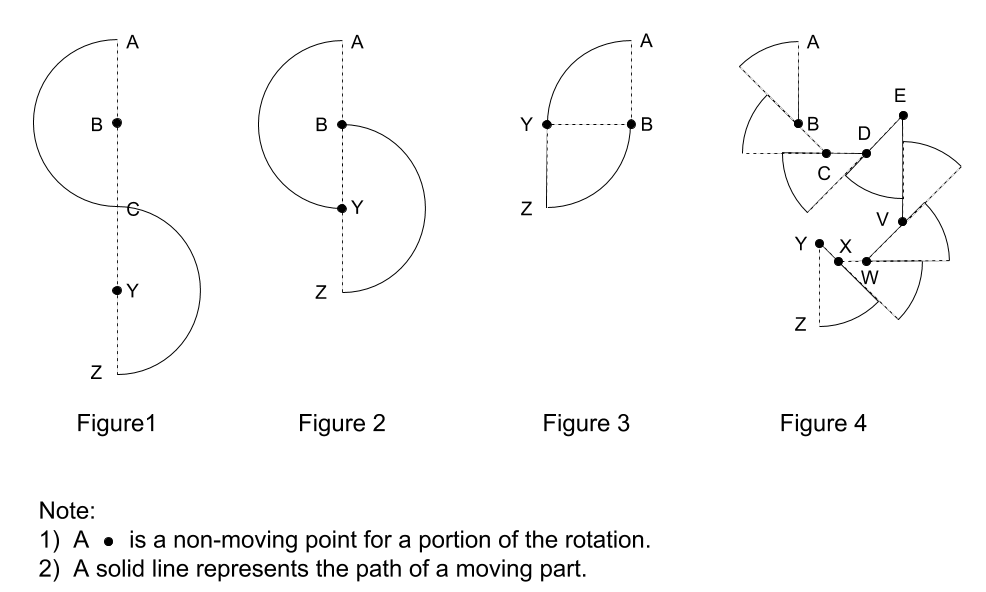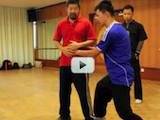In taijiquan, we often hear people refer to a circle, drawing a circle, or being rounded. The essence of a circle is rotation. It is by rotation that a dot on the surface of any object can draw a circle. A sphere or ball is the 3D extension of a circle. A circle also has the characteristic of a loop, where there is no beginning or end, in the other words, anywhere can be the beginning which can then be the end. To complete a rotation, there is a one-way path from beginning to end, and there is no going backwards on the same path, otherwise, it is equivalent to nothing happens at all.
Due to the way a human is built, we cannot perform a true rotation. What can be achieved is an approximation of it, and we can perform a portion of a rotation at a time. In order to perform a full rotation, switching is required. Switching can refer to switching of pivots (non-moving parts) or switching of moving parts.
In Figure 1, line AB rotates around point B to become line CB. Line CB moves laterally to become line YC. Y becomes the new fixed point. Line CY rotates around Y to become ZY. This represents a full rotation by having two action halves. This is the S-curve often referred by Master Chen Zhonghua. It marks the way in which the human body performs a circle. Note that this is also the taiji symbol.
Figure 2 is similar to Figure 1 except no lateral move, and there is a direct switching from point B to point Y as the non-moving point.
Figure 3 also represents a full rotation, although it may not look like one at first glance. There are two halves. In this case, the circle is smaller, and in fact, it is more like an ellipse.
Figure 4 represents a full rotation that is further broken down. Switching of pivots is depicted here (points B,C,D,E,V,W,X,Y). For simplicity of the drawing, 8 equal pieces are used, however in reality, they do not need to be equal in size. The overall shape is also asymmetric. This is a 2D representation. Imagine how crooked it will look if the pivots are not located on the same plane.
In order for each portion of a rotation to continue from the last one, what is gained in each portion must be maintained/kept, so that position becomes the starting point of the next one. Let’s take the right-side positive circle in Practical Method as an example. In the most basic version, we do a 3-count circle:
- In with elbow
- Turn with waist
- Out with hand
After the first count, the elbow must touch the side-ribs. In the 2nd count, while the elbow is touching the ribs, pushing the right foot to the ground and rotating the right kua with the left kua being the pivot cause the waist to turn to the left. This is the first half of the circle. For the 3rd count, using the right kua as the pivot, pushing the left foot to the ground and rotating the left kua causes the right hand to go out as part of the geared action. This completes the 2nd half of the circle. Note that the waist turn is only going to the left in one direction throughout the entire circle. There is no reset.
Let’s look at only the relationship between the elbow and the hand. The in-with-elbow-no-hand is the first half of a circle, and the out-with-hand-no-elbow is the 2nd half of a circle. This is an example of switching of moving parts. After the in-with-elbow-no-hand, the elbow continues to go inwards (no loss of compression towards the dantien) while the out-with-hand-no-elbow takes place maintaining the tension between hand and elbow.
The four figures above show different representations of the S-curve that involve physical actions. Master Chen has also shown before that having a particular physical shape in the body with various stretches can allow energy to travel in a rotating fashion without any obvious external movements. That is another topic for the future. At the mean time, keep practicing.




{ 7 comments… read them below or add one }
The angle is changed by rotating the line by way of the front kua transferring power from the ground, to the waist, causing the waist to rotate backwards until it reaches the rear kua and rear foot. As we already discussed this changes the angle. I worked on this with my student Gerry this morning. What I realized was changing the angle causes your vertical line to cross the opponent’s line horizontally, thus “cutting” their line reducing it’s length while one’s own length is maintained, which increases your power and reduces the opponent’s power….the posture in the yilu that this is present is Reversed Coiling of Forearm (Dao Juan Gong 倒卷肱).
Vertical line refers to the length (long) of the line while horizontal refers to the width (short) of the line…
I confirmed the following with John regarding the scenario he referred to:
The opponent is pushing you. There is a line from the opponent’s rear foot to a contact point with you and there is another line from that contact point to your rear foot. You match the incoming force. You rotate your front kua causing your waist to turn while keep the incoming force matched, therefore, no tossing anywhere. You now do a hand-out towards the line established by the opponent, and it intersects his line and cuts off his power.
Hallo Kelvin,
I always like to reread this post and think about your statements. But I feel I haven’t understood everything you mentioned yet, so I feel free to ask for further clarifications. My problems begin with the part after the listing 1-3. For 1 and 2 you mention the pivot is the left Kua. I feel the pivot at 1 is the right kua, for 2 – if the opponent pushes further – the pivot is the centreline and for 3 the pivot is the left kua (you mention the right kua).
I also cannot grasp your idea, that the waist only turns further left, when the left leg pushes into the ground and the left kua opens in 3. Isn’t it anatomically impossible, that the left kua opens to the left? If in an imagined circle on the left, in step 2 the waist would turn to the right. In this movement, the left leg would do the same as in step 3 of a circle on the right side, which is pushing into the ground. How could the waist therefor turn in different directions, when the leg is doing the same thing?
So I guess there is something in your ideas, that I haven’t understood. If your time allows, I would be very grateful, if you could elaborate your extremely interesting ideas a bit further.
Peter
Hi Peter!
Students writing articles is an activity of study for those individuals, and a method of producing a record for later comparison with themselves and their (changing) understanding. It is a contribution of participation for our community.
We, as students, read each other’s articles for interest, support and motivation, and we may pick up tidbits here or there, but we are all studying from our teacher, Master Chen Zhonghua. We have so little time, we need to review and rework (train) his material as much as possible.
When studying, a clear dinstinction must be made between theoretical discussions and practical training. This also applies when writing an article; we must know and state when we are drawing out an idea (hypothesis) versus actually doing and describing a movement (that we can do). Making things up about something that is real and measurable is anathema to our method.
The above article is the author’s understanding at the time of writing. We can not expect it to be correct. In fact, Master Chen asks us to recognise that we are studying (physically) *because* we are incorrect. As students, we mainly write (as we do the yilu routine) to expose our flaws. If we do not expose them, we cannot improve.
Resources of Master Chen instructing on learning and the S-line (highly recommended!!):
—————————————————————————————-
http://practicalmethod.com/2013/02/6-stages-of-learning-tai-chi/
http://practicalmethod.com/2015/05/learning-practical-method/
From the above video:
“I basically don’t teach, in the conventional sense.”
“Number one is the principle, but there are different methods.”
“I don’t want to specify what method, but you must understand the principle. If you don’t understand the principle, you don’t know what you are doing and whatever you do is a waste of your time.”
(There is also a big secret at the end of this video!)
http://practicalmethod.com/2010/12/taiji-s-line-demonstration/
http://practicalmethod.com/2010/11/taiji-s-line-online-video-trailer/
Hope this helps! Train lots! *First* physical understanding *followed by* mental understanding!
Peter,
Thanks for your question. It is difficult to put in words for the specific actions.
In terms of performing positive circle, Master Chen has previously shown me different variations of a circle in terms of using different axes. For example, right shoulder-to-right kua, central vertical axis (head-to-tail bone), left shoulder-to-left kua. The above is attempting to describe one case. It is like you can mix and match which axis to use in either half of the circle. However, regardless of which axis is used, nothing appears to move externally.
I had the same confusion at the beginning when Master Chen said there was no reset in the circle. How was it possible to turn the waist without going back in a circle? If the kua is open, then it is not limited to a 2-D action (like open or closing a door). I find that the two kuas can open in different directions in a circle to allow what was described above.
Hopefully, you will meet Master Chen or someone from Practical Method, who can demonstrate to give you a better idea.
Kelvin,
“If the kua is open, then it is not limited to a 2-D action”….this is a very good point. Thanks for your reply.
Peter